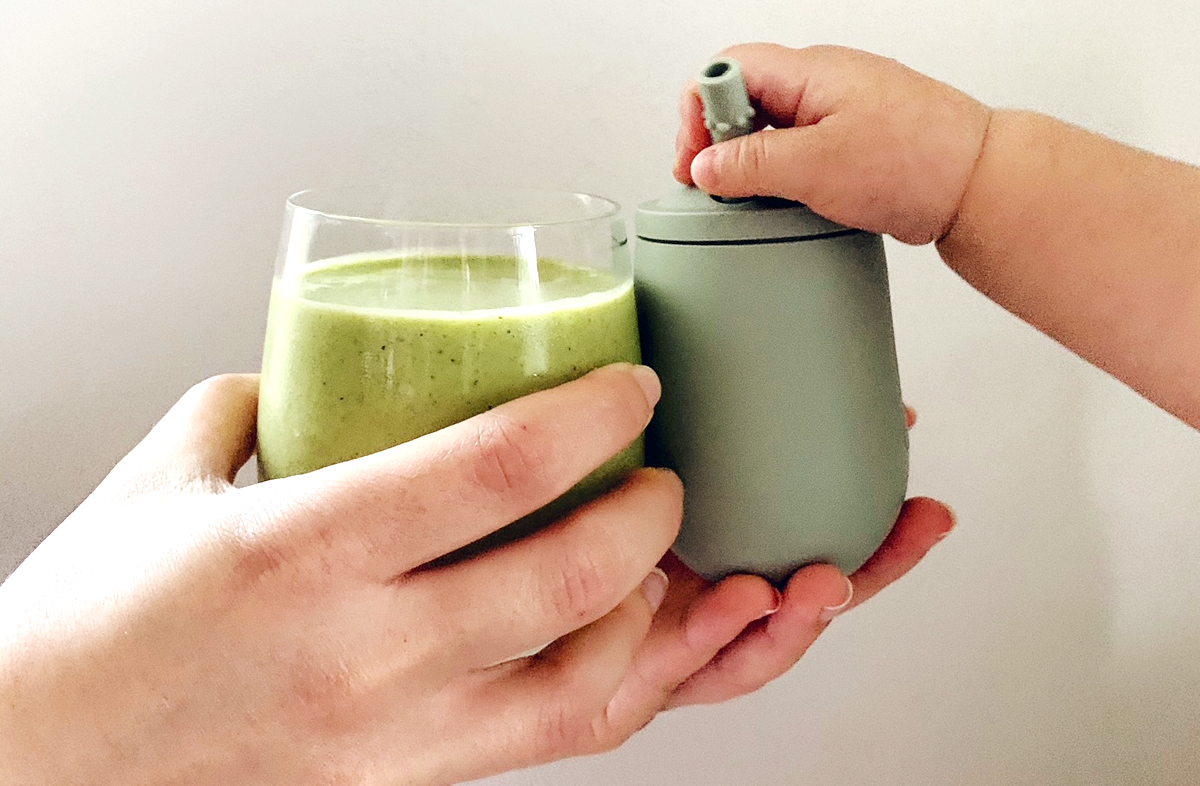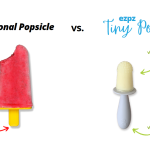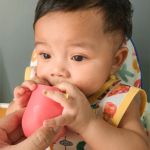Straw Drinking Milestones

Learning to drink from a straw is an important developmental milestone. I designed the ezpz Mini Cup + Straw Training System to help babies and toddlers learn how to perform this skill safely. Here are five tips to help you teach your little one to use a straw safely and successfully.
1. Timing
Throughout my (27+ years) feeding career, I have observed a lot of families and therapists trying to teach straw drinking to a baby between the ages of 4-8 months. Although some babies have the coordination to do this early, I find that most are not ready for this skill. These babies experience coughing, choking, and even have increased episodes of ear infections (because many of them lack the proficiency to drink from a straw safely).
Straw drinking is a complex skill for young infants to learn. They have to suck, hold their breath, swallow, exhale and then breathe again. Introducing straw drinking too early can be an uncomfortable and sometimes painful experience, and some babies may refuse to drink from a straw cup again. This can make weaning off a bottle a more complicated and lengthy transition.
2. Transition
As an infant swallowing specialist, I have taught thousands of babies how to learn to drink from a straw. I find the “sweet spot” for starting straw drinking is at 9 months of age. This age is perfect timing for a parent’s sanity too, and here’s why. Developmentally, babies drink from an open cup (held by an adult) from 4-9 months (with breastmilk, formula, purees, and smoothies). At around 9 months, babies want to start holding the cup by themselves, and there is A LOT of spilling going on, so this is a perfect time to introduce a straw cup!
3. Timeline
Although developmental ages are approximate and vary with each baby, here is a straightforward timeline for parents to consider:
Age Range: 4-6 months
- Skill: Open cup drinking
- Milestone: Baby will drink from an open cup (held by an adult)
- Product: ezpz Tiny Cup
Age Range: 12 months
- Skill: Open cup drinking
- Milestone: Baby will drink from an open cup (independently with spillage)
- Product: ezpz Tiny Cup
Age Range: 9-15 months
- Skill: Straw cup drinking
- Milestone: Toddler will drink from a straw independently
- Product: ezpz Mini Cup + Straw Training System (includes a toddler open cup + straw/lid system)
4. Textures
I like to teach children to use a straw with a thicker liquid first, like a puree. Then, once they are successful with that texture, I offer thinner purees and breastmilk or formula. Finally, I offer water at around 9 months of age. Thin liquids are the most challenging texture for babies to swallow safely consistently, so I offer water after a baby has mastered straw drinking.
5. Teaching
Some babies initially struggle with straw drinking. To make the transition easy, be sure your baby has first mastered their open cup milestone (drinking from an open cup held by an adult). This milestone helps to ensure that baby has adequate lip closure and their suck-swallow-breath synchrony is intact. These oral-motor skills (on an open cup) are the foundation for safe straw drinking. When starting straw drinking, remember to offer a liquid with a thicker consistency.
Steps
Here are a few steps to help you teach straw drinking:
- Take the Mini Straw and place the “training side” of the straw (curved with sensory bumps) into the puree or thick liquid. Then, cover the other end with your finger. This will draw a small amount of food/liquid into the straw.
- Place the “training” end (with the sensory bumps) towards your baby’s lips, but don’t put it in their mouth. Instead, encourage your child to lean toward the straw to independently place their lips on it.
- Then slowly release your finger, so they receive a tiny sip. This will help your child to have good lip rounding while learning to swallow from the straw.
- Practice this strategy a few times until you feel your child actively sucking from the straw. Then place the Mini Straw back into the Mini Cup and encourage your little one to try drinking from it using the sensory bumps and straw angle to help facilitate a safe swallow.
- After a few weeks of practice using the training straw and making sure your baby is placing their lips at the tip of the straw (where the sensory bumps are), it’s time to move to the “advanced side” of the straw.
- All you have to do is flip the training side of the straw (curved with sensory bumps) over to reveal the “advanced side” (straight with no sensory bumps) of the straw. Then, continue to practice straw drinking with this side of the straw. You did it!
Safe straw drinking is a critical skill to learn to foster drinking independence. How will your family teach straw drinking to your little one? If you try the Mini Cup + Straw Training System I designed, please share your straw drinking success with me using the hashtag #MsDawnSLP!





